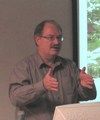FLASHBACK TO 2010 FROM RAIN TO RESOURCE WORKSHOP: “The Water Balance Model is a response to the need to quickly test alternative green infrastructure techniques prior to implementation,” stated Jim Dumont

“The WBM allows the user to quickly establish the existing, or the predevelopment, base line that will become the standard used to measure the performance of future development scenarios during the planning and design of a project. This allows the user to test various methods to establish the easiest and best ways to achieve the most desirable vision of the future for the Site, the Development, or the Watershed,” stated Jim Dumont.










